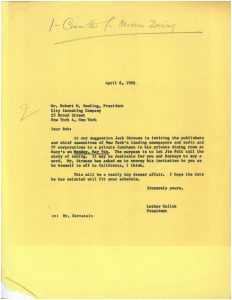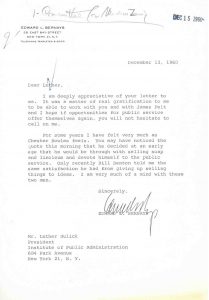
1916 zoning map of NYC showing the allowable height of buildings in relation to the width of the street they were on: a 2 means buildings without setbacks could rise only double the 60-foot width of the street, or 120 feet.
One of the most amazing things about our historic collections in the Baruch College Library Archives is how they surprisingly intersect. Our distinguished namesake, financier Bernard Baruch,
https://www.baruch.cuny.edu/library/alumni/online_exhibits/digital/2008/bernard/exhibit1.html
turned out to have worked with reformer extraordinaire Luther Gulick in FDR’s wartime councils. Bernard Baruch rubbed shoulders with Edward L. Bernays, the wily father of public relations and nephew of Sigmund Freud, whose extensive library and artifacts are on loan to the Archives as the Museum of Public Relations. (Bernays got BB, along with Clarence Darrow, Anne Morrow Lindbergh, Ida Tarbell, and J. P. Morgan’s sister, among other luminaries, to attend a 1931 gala launch for muckraker Lincoln Steffens’s classic autobiography — how’s that for name-dropping?)
And now, we see, Bernays and Gulick worked hand in hand in 1960 to bring New York City a momentous modern zoning code. (Later they would collaborate to bring fluoridation to New York’s water.)
Gulick was present at the creation…of zoning. At age 24, a graduate student at Columbia and student at the Training School for Public Service, founded in 1911 by Mrs. E.H. Harriman, he was eyewitness to the 1916 debate in the Board of Estimate that gave New York — and America — their first zoning ordinance.
www1.nyc.gov/site/planning/about/city-planning-history.page
The revolutionary “zone resolution” (marking its centenary this year) did not rule out skyscrapers (yes the word was already in use in 1916) but limited their maximum height to two and a half times the width of the street they fronted, unless they were set back or covered less than their entire lot. Thus, the bulky twin-slabbed Equitable Building, which had already risen a massive 40 stories at 120 Broadway, throwing a swath of lower Manhattan into shadow, would only have been permitted to rise 18 stories. It was too late to alter that — and the impending restrictions brought a flood of plans by developers scrambling to get their outsize projects approved before the regulatory door slammed shut. But later towers like the Chrysler and Empire State Buildings were able to soar and still let in the light, thanks to slenderer construction and setbacks.
http://untappedcities.com/2011/12/07/how-zoning-shaped-the-new-york-skyline/
The 1916 zoning ordinance had other features. It protected the stylish Fifth Avenue shopping district from encroachment by factories. And it created large “undetermined districts” along the waterfronts that were open to residential and business development (though not high office buildings) pending future restrictions. One dispute pitted J.P. Morgan, who wanted the area on Madison Avenue in the 30s near his mansion ruled free of business development, against William Waldorf Astor, who objected to the restriction. Morgan prevailed — at least for a time.
By 1940 with the creation of the City Planning Commission, some zoning amendments were adopted, But a decade later it was clear a more comprehensive revision was needed. For one thing, New York and its nearly 8 million people were being overrun by the automobile and in dire need of more parking than the streets would allow. For another thing, the 1916 code allowed for a city of more than 55 million people.
In 1950, Robert F. Wagner, then the planning chairman, commissioned a zoning study but nothing came of it until 1956 (three years after Wagner’s election as Mayor) when the Board of Estimate contracted with outside planners for a major new look at zoning.
It was released in 1959 and became the subject of heated debate at a series of hearings into 1960, with many elected officials and tycoons, fearing curbs on development, in opposition.
This time around, Luther Gulick — who had served as New York’s first City Administrator under Mayor Wagner — was co-chairman of the Committee for Modern Zoning, a stellar assemblage of the city’s highborn elite under planning commissioner James Felt. As Gulick dramatically testified: “Forty-four years ago, I sat in this very room and heard the public and the Board of Estimate and the experts debating the New York Zoning Act of 1916.” (Leave it to Gulick to bridge two major municipal landmarks — in 1916 and 1960.) Some of the same fears of commercial damage were voiced then as now, he declared. “They were dead wrong in 1916 and they are dead wrong now.”

Gulick (top left and top and bottom right) with other planning officials during the 1960 zoning debate. The contact sheet was found in an IPA Collection folder on zoning.
Among the innovations were provisions for more garages and new categories of residential districts, from single-family to high-density, and commercial districts set aside for downtown local shopping and outlying shopping centers; waterfront recreation; commercial amusement; and heavy services like manufacturing. Unsightly facilities like coalyards, junkyards, auto wreckers and billboards were to be phased out.
This time too, Gulick and the pro-zoning forces had a powerful ally — Edward Bernays.
https://www.nytimes.com/books/98/08/16/reviews/980816.16chernot.html
Bernays (whose library and other materials are on loan to the Baruch Archives by the Museum of Public Relations) boasted psychiatric royalty — his mother was Freud’s sister and his father’s sister was Freud’s wife. And he used his uncle’s discipline to shape history, employing the skills of mass psychology and propaganda on behalf of his clients to get women to smoke cigarettes and wear green (the better to go with Lucky Strike packs) and American families to eat bacon and eggs for breakfast and fight cavities with fluoride (a by-product of his aluminum-manufacturing clients).
Like Gulick, Bernays was a survivor. In fact, they were contemporaries and would live to be fellow centenarians. Bernays, born in 1891 (two months before Gulick) lived to 103; Gulick died at nearly 101 in 1993. Both were born before the advent of the automobile, airplane, movies, radio, television, space travel and the Internet. Both began their public careers in the administration of Woodrow Wilson and both lived to see Bill Clinton elected President. And both would work together on the bitter 10-year fight from the mid-50’s to 60’s to fluoridate the city’s water. https://blogs.baruch.cuny.edu/ipaprocessing/2015/02/sinking-his-teet…nto-fluoridation/
Bernays quickly harnessed his publicity know-how to the task of rallying support for the 1960 zoning revolution.
It worked!
In his 1965 autobiography, “Biography of an Idea,” Bernays recalled the victory with relish.
And now? New York is ripe for another look at zoning — in case you haven’t noticed the megatowers springing up in midtown Manhattan.













